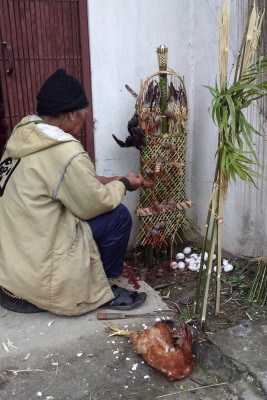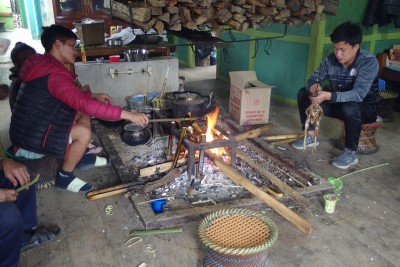The Shaman of Hari
(thomas;2023-June-25)
 Ziro is a large valley in Arunachal Pradesh, famous for its extensive rice paddies. There's one town in the valley surrounded by dozens of tribal villages (some more hamlets than villages) with the biggest tribe in the region being the Apa Tanis. While exploring the valley's many villages, we came across a few places where there had been (and sometimes still was) a festival in place. One such village was Hari and it was there that we participated in a full Shamanic ritual. One of the interesting features of this region is the pervading mix of old Shamanic beliefs with Christian faiths (mostly various Baptists churches). Most people in Ziro would describe themselves as Christians and we can vouch for the fact that the churches (always the biggest and brightest buildings around) are very well visited on Sunday mornings. However... the old beliefs were perhaps there for a good reason and it can't hurt to have a second set of rituals, can it? So both "schools of thought" live happily and peacefully side by side in the minds of the locals.
Ziro is a large valley in Arunachal Pradesh, famous for its extensive rice paddies. There's one town in the valley surrounded by dozens of tribal villages (some more hamlets than villages) with the biggest tribe in the region being the Apa Tanis. While exploring the valley's many villages, we came across a few places where there had been (and sometimes still was) a festival in place. One such village was Hari and it was there that we participated in a full Shamanic ritual. One of the interesting features of this region is the pervading mix of old Shamanic beliefs with Christian faiths (mostly various Baptists churches). Most people in Ziro would describe themselves as Christians and we can vouch for the fact that the churches (always the biggest and brightest buildings around) are very well visited on Sunday mornings. However... the old beliefs were perhaps there for a good reason and it can't hurt to have a second set of rituals, can it? So both "schools of thought" live happily and peacefully side by side in the minds of the locals.
 So in Hari we saw that old man in front of what looked like a makeshift altar, doing his routine. This started with the opening a few eggs and distributing the eggshells in front of the altar (the yolks are filled into bamboo shells and taken inside to be grilled over a fire). Then came the sacrificing of three birds (one chicken, a smaller, darker bird we could not identify and finally a chick) and ceremoniously blessing various parts of the altar with the birds' blood. It turned out that the man was the village's Shaman (every village has one but only one Shaman who is one of the most important persons in the village). One thing we found amazing is that none of the birds, perhaps soothed by the Shaman's incessant murmuring, offered any resistance or showed any signs of fear, not even a single squeak.
So in Hari we saw that old man in front of what looked like a makeshift altar, doing his routine. This started with the opening a few eggs and distributing the eggshells in front of the altar (the yolks are filled into bamboo shells and taken inside to be grilled over a fire). Then came the sacrificing of three birds (one chicken, a smaller, darker bird we could not identify and finally a chick) and ceremoniously blessing various parts of the altar with the birds' blood. It turned out that the man was the village's Shaman (every village has one but only one Shaman who is one of the most important persons in the village). One thing we found amazing is that none of the birds, perhaps soothed by the Shaman's incessant murmuring, offered any resistance or showed any signs of fear, not even a single squeak.
After the sacrifices and the blessings the Shaman repairs into the house of the host where the birds (minus their livers) are taken by the males and put over a roaring open fire (feathers and all), to be grilled and eaten later with the egg yolks. The Shaman who has kept the birds' livers now begins to study their sizes, shapes and colour with a view to determine what the coming year holds for the host and his family. We were told that this omen-reading procedure never yields negative results... it's always more or less "good" (perhaps an effect of a sort of competition with the Christian churches?) After this, the Shaman and then everybody else get a glass or two of rice beer and some snacks. We can confirm that this beverage is pretty strong.
We have a video of the ritual, but be aware that the ceremony might not be for squeamish people:
Want to read more? Go back to Ali in Kohima or go on to The Archers of Tawang or go up to Meet the Locals
$updated from: Blog.htxt Mon 04 Mar 2024 16:04:39 trvl2 (By Vero and Thomas Lauer)$



